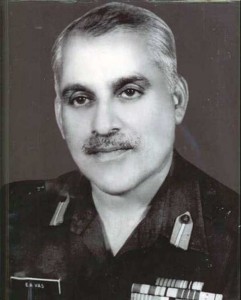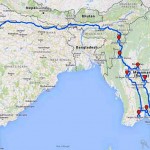IDR Blog
Security Doctrine : Approach Paper
In a tribute to Lt Gen Eric Vas, whose perceptive insight is evidently still relevant.
It is agreed that there is nothing secret about a national security or service doctrine. Thus, there should be no hesitation in disseminating the views expressed below to the public in order to encourage wide debate and discussion.
As rightly stated, an authentic army doctrine cannot be framed until a national strategy is announced and a joint inter-service doctrine is formulated to support this. In the absence of these two essential pre- requisite, the army is forced to evolve its own interpretation of a national strategy. This is an unsatisfactory state of affairs.
Pakistan’s aim will attempt to win the hearts and minds of a sizeable Muslim constituency in India in order to foster internal threats, undermine Indian society and resolve the Kashmir issue to their advantage.
However, while making our own assumptions, two assessments are undisputed in the coming decade:-
- that our strategic posture against China should be defensive.
- that our counter-insurgency operations in J & K must be pursued relentlessly.
However, the strategic options along the international boundary with Pakistan are less evident. Current events in Pakistan suggest that the country is undergoing adverse and contrary economic, social, psychological and political pressures. Two scenarios may be considered in the coming decade:-
- The Pak Govt., with the help of the army, succeeds in curbing fundamentalism, reforming the educational system, guiding the country towards the process of modernization and a Turkish-type political structure.
- The internal situation deteriorates, peripheral regions remain opposed to central rule, the demand for a free and unfettered democracy and regional autonomy escalates, and the Govt. is forced to give in to the demands of the people.
Other scenarios are sometimes discussed. Wishful thinkers claim that Pakistan will break up into regional groups. Some pessimists say that the fundamentalists will overcome the moderates and gain power. Whereas these two situations are possible, they are not considered very likely.
India’s strategic posture against Pakistan should be defensive. Nevertheless, India must always maintain a military edge over Pakistan; there is no better assurance for peace than military strength.
Whatever happens in Pakistan, we must accept that their political aim cannot be the acquisition of territory by the use of military force. A more likely aim will attempt to win the hearts and minds of a sizeable Muslim constituency in India in order to foster internal threats, undermine Indian society and resolve the Kashmir issue to their advantage. Therefore, the question of a Pakistani military offensive across the border into India in the coming decade is most unlikely. A continuation of sponsored terrorism at selected targets is likely. The armed forces must be clearly told what offensive steps, short of war, are permissible against Pakistan in order to make that country pay a high price for sponsoring cross border terrorism
Thus, India’s strategic posture against Pakistan should be defensive. Nevertheless, India must always maintain a military edge over Pakistan; there is no better assurance for peace than military strength. However, the earmarking, equipping and training of strike forces for a deep offensive into Pakistan is unrealistic. Strong mobile offensive elements with offensive capability must be located.in reserve to support the holding forces. These reserves must be highly mobile, modernized and given hi-tech equipment. Forces earmarked in a defensive role need not be mobile and must be orgainised and equipped for a holding role.
Technology undoubtedly changes the concept of warfare. But India should acquire appropriate high-tech weapons and equipment to match its strategic and tactical needs. India will not be involved in a battle with a NATO-type opponent or the US army. Our forces earmarked for a holding role or for counter-insurgency operations do not require the high-tech that our mobile reserve forces require. Our technology must also be socially and psychologically relevant; we must never forget that the rural sphere from which our jawans are recruited is underdeveloped and poor. Now is the time for the armed forces and the government to plan for “a decade of self respect”. The government should ban the import of the following:-
India has been manufacturing small arms and ammunition since 1914, and has the industrial skill to produce all these items, provided there is political will…
- Tanks, aircraft, warships, submarines and helicopters
- guns, small arms and ammunition
- radios and radar.
India has been manufacturing small arms and ammunition since 1914, and has the industrial skill to produce all these items, provided there is political will, and accountable managerial controls are imposed ruthlessly on those put in charge of the projects concerned.
The present designation of a service chief as a service chief of staff is a total misnomer. The present organisation of a Defence Ministry is absurd and inefficient. The coming decade provides an ideal opportunity for the government to reorganise and reform the political-military higher command structure. This will entail-
- the creation of three service councils each composed of their respective chiefs, his principal staff officers and a civil servant. An elected politician will head each council.
- Dismantling of the existing three service HQs and Defence Ministry, and the replacing of these by three integrated [civil-military] service HQs governed by the service council mentioned above. This will result in a drastic reduction of military officers and civil servants and a consequent release of valuable office and residential accommodation in Delhi. This will also result in the saving of crores of rupees every year
- It is only after this is done that the need for a Chief of Defence [CDS] staff will arise. The current continual debate about the need for a CDS is meaningless and is putting the cart before the horse.
- There is nothing revolutionary or original in these proposals. Such a system prevails in all democracies, and was introduced in the UK after World War 1
In the coming decade we should modernize the navy selectively in specific areas e.g. air craft carrier, mine laying and lifting, long range air surveillance, submarine operations and so on.
India’s national strategy must clearly outline its nuclear doctrine. A policy statement of “no first use” and confidence building measures with Pakistan are not doctrines. We can be sure that pressure is soon going to come on India and Pakistan to give up nuclear weapons. Pakistan will take the stand that it will renounce NW if India does the same. India’s NW doctrine must therefore cater for this contingency in the coming decade. It has three options-
- renounce NW
- defy world order and pursue a NW deterrent strategy
- adopt a via media.
INPAD has written extensively on what this via media NW strategy ought to be. [Happily we have been in touch with successive governments on this issue since the past 20 years.] This is not the venue for a detailed consideration of this issue. Sufficient to say that INPAD’s Sataygraha Strategy advises that India must-
- refuse to accept a 5-NW state hegemony. Must insist that all NW are a danger to mankind and must be placed under international control.
- Continue to display its capability to produce long range missiles and nuclear warheads, raise missile units that could handle these if required and establish a NW strategic force command to control these if required.
- Reassure the world that its missiles are only armed with conventional warheads. Reassure the world that though it has displayed its capability, it voluntarily renounces the conversion of this capability into an outright possession of NW
- Urge that the first priority is for all nations to sign a Fissile Material Control Treaty [FMCT]. India will be happy to sign this
- Continue to avoid signing the NPT and CTBT until the 5 NW place their NW under UN control.
…the activities listed above will entail great expense but must be undertaken and without relationship to any perceived or imagined threats. This is a Skill-based Strategy as opposed to a Threat-based Strategy.
A proposed Naval Doctrine must be discussed as it has a great economic influence on our overall defence budget. Under the circumstances discussed above, it is unreal for the navy to insist on a two-fleet navy; one for the Arabian Sea and another for the Bay of Bengal. On the other hand it is agreed that naval planning must be long term. In the coming decade we should modernize the navy selectively in specific areas e.g. air craft carrier, mine laying and lifting, long range air surveillance, submarine operations and so on.
Undoubtedly the activities listed above will entail great expense but must be undertaken and without relationship to any perceived or imagined threats. This is a Skill-based Strategy as opposed to a Threat-based Strategy. The concept is that the navy needs too modernize so that it acquires the state of the art technology in all naval spheres and learns to maintain and train for the next decade. This strategy saves naval officers from being forced to invent unreal current threats to justify essential procurements. That is a demoralizing procedure and must adversely effect the morale of all ranks who know that the threats are unreal.
(First published on Inpad site in 2004)





